Not only beauty or sleep aid, but this spice also helps you to have a healthy heart; if you also practice cardio exercises, great!
The spice we are going to talk about in today's post is Saffron.
Have you ever heard of the presence of the “golden spice” saffron from Iran?
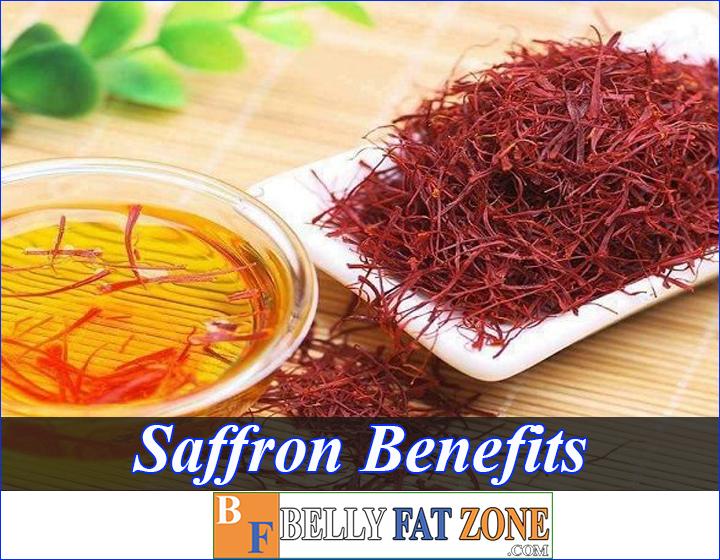
If you do not know one of the most expensive spices in the world, today, BellyFatZone will introduce you to Iranian saffron – a representative in the spice industry.
1. What is Saffron?
Saffron is a spice harvested from the pistil of an autumn flowering plant called Crocus Linnaeus, also known as the saffron plant.
Saffron is a plant that belongs to the Danyang family, can grow up to 20-30 cm and blooms four flowers. The saffron flower has six beautiful purple petals; the flower can sometimes be pink. Each saffron flower has three red stamens and one pistil.
Saffron is commonly consumed in two forms: dried and powder.
2. The history of Iran saffron
Saffron is considered one of the most expensive spices in the world. The word “saffron” comes from the Arabic word zafaran.
Researchers have shown that the saffron pistil originated from the Zagros mountains in Iran more than 4000 years ago through historical documents.

Perhaps this is why the Iranian saffron pistil has an attractive aroma, distinctive color, and rich nutritional value.
For a long time, Iranian saffron has held a foothold in the world, and it also has many different types of consumption:
- In the food industry: Saffron can be used as food, drinks, and delicious desserts (such as saffron tea, saffron rice, saffron Tah – Chin, saffron syrup, saffron cake, …).
- In the dying industry: Saffron is used in hair and clothing dyeing.
- In the medical field: Recently, saffron is considered a “medicinal” good for the skin, nerves, treating several diseases such as heart disease, diabetes, stomach pain, …
3. The special feature of Iranian saffron compared to other types of saffron
For some suppliers, it is quite common to use safranal – an additive. However, the safranal content in Iran's saffron exports is the least.
More specifically, the amount of safranal in Iran's saffron pistil is only about 1% or less. So the taste and aroma of Iranian saffron are very close to the original.
Plus, the excellent climatic conditions for Iran's saffron cultivation have made the country's saffron the top 1 quality globally.
The eastern and northeastern parts of Iran, including southern Khorasan and Ghayenat, are home to high quality and pure saffron production.
Every year, Iran's saffron meets 90-93% of the demand for saffron pistil worldwide.
4. Classification of Iran saffron
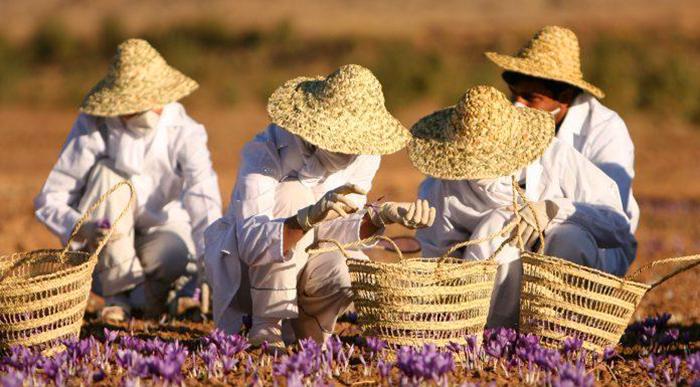
Saffron Iran fibers are divided into 5 main categories:
Negin Saffron
When the first three strands of the pistil are attached in a cluster, the saffron is called the Negin.
Since Negin Saffron's production requires exact and sophisticated handcrafting skills, this saffron is supplied in minimal quantities and is very expensive.
Its fibers are longer, thicker, and break less than other saffrons. Negin Saffron is a pure type, has had the stigma removed and retained the red part of the stigma.
It is also the most expensive Iranian saffron on the market. The quality of its scent and color is also among the best.
- Humidity: below 8%
- Color: Negin Saffron is all dark red.
- Size: about 1.5 cm long
- Color intensity: greater than 250 USP
Sargol Saffron (or All-red Saffron)
Each year in Iran, this saffron is exported more because it is cheaper and available worldwide. Sargol Saffron is made from saffron fibers that are stamen free and less fractured.
It is known that to make 1 kg of Sargol Saffron requires 105 – 115 kg of the saffron flower.
- Humidity: 8% at most
- Color: Sargol Saffron is red
- Size: about 1 cm long
- Color intensity: 220 – 270 USP
Poushali Saffron
Poushali Saffron is a type of pistil containing filaments with a 2 – 3 mm long stigma. The appearance of the stigma in this saffron (the yellow part) gives an olfactory aroma.
- Humidity: below 7%
- Colors: Poushali Saffron comes in red and yellow but has a more red part.
- Size: about 1 – 1.5 cm long
- Color intensity: about 220 USP
Bunch Saffron (or Dasteh Saffron)
Bunch Saffron consists of all parts of the saffron stamen, with the stamen part maintained. The red part of the stigma and the white/yellow part of the stigma is attached.
In fact, the red part of Bunch Saffron accounts for about 70 – 75%, and the white and yellow parts make up about 25-30% of the length of the stamen.
- Humidity: below 8%
- Color: Bunch Saffron is red, white, and yellow; the red part takes up more.
- Size: about 2 – 3 cm long
- Color intensity: 190 – 210 USP
Konj Saffron (or White Saffron)
Konj Saffron is the white/yellow foot leftover of the pistil after manufacturing the above saffrons. In Europe, it is known as White Saffron or Style Saffron.
Read more: Vitamin E Benefits And The Most Effective Way To Use It.
5. The nutritional value of Iranian saffron
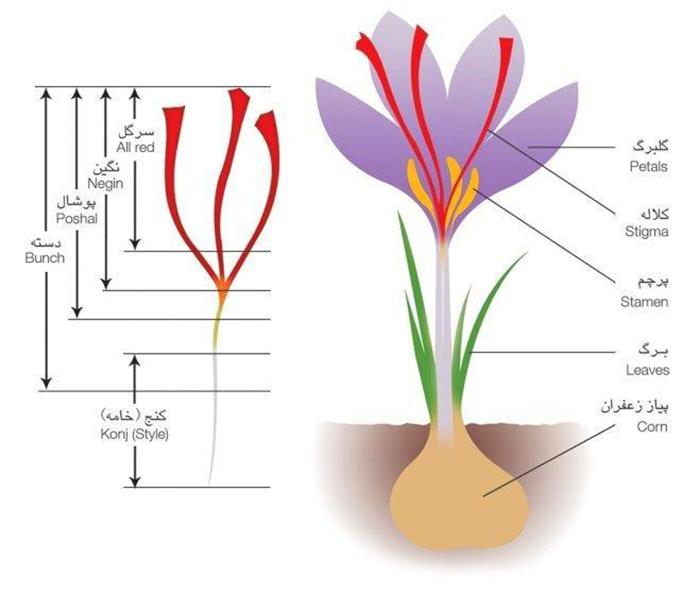
Saffron Iran is a nutritious food source rich in minerals, vitamins, fatty acids, protein, fiber, and antioxidants.
You can see the nutritional value table of Iranian saffron below for more details:
| Nutritional information | Values per 100 g |
| Potassium | 252 mg |
| Calcium | 111 mg |
| Phosphorus | 252 mg |
| Iron | 11.1 mg |
| Copper | 0.3 mg |
| Manganese | 28.4 mg |
| Magnesium | 264 mg |
| Selenium | 5.6 mg |
| Zinc | 1.1 mg |
| Vitamin C | 80 mg |
| Vitamin A | 330 IU |
| Vitamin B9 (folate) | 1 mg |
| Omega-3 and omega-6 | 5.8 g |
| The protein | 11.43 g |
6. Effects of the saffron pistil
- Preventing cancer
- Saffron pistil cure insomnia
- Reduce menstrual symptoms
- Support for treatment of depression, dementia
Scientists prove saffron pistil to be equivalent to an adjunct to the treatment of depression, reducing many neurological diseases.
The constituent compounds of saffron such as flavonoids, tannins, anthocyanins, alkaloids, and saponins work to balance neurotransmitters in the brain, especially serotonin loss – one of the main causes of depression.
Improve digestive system

Saffron contains a substance called carotenoid that plays an important role in promoting the digestive system, has anti-inflammatory properties, supports the treatment of digestive disorders, stomach ulcers, ulcerative colitis.
You only need to use a small amount of saffron pistil soaked in warm water or mixed with honey every morning after waking up regularly, and you will see a significant improvement in your digestion.
Good for heart health
Saffron's antioxidant and anti-inflammatory properties help maintain healthy arteries and blood vessels.

Besides, saffron pistil also contains Riboflavin, Crocetti, and some other important vitamins that regulate cholesterol in the blood, fight atherosclerosis and lower blood pressure.
Besides, saffron pistil increases the ability to absorb potassium into the body, reduces pressure on the arteries, reduces stress on the cardiovascular regulation system.
Improved eyesight
A large amount of Crocin present in saffron helps circulate blood to the retina and chorion. It is used to aid in treating neuropathy and clear free radicals that cause macular damage.
Carotenoids such as zeaxanthin and the flavonoid in saffron also slow down the aging of retinal cells.
Besides, saffron pistil also has “pre-vitamin A,” such as alpha-carotene and beta carotene, which are nutrients for the eyes, making vision cells more flexible.
Premium spices in cuisine
Saffron pistil is often used to create special colors and flavors for high-end dishes of India, France, Italy, Spain, Sweden, …
How to drink saffron pistil for health care
- Drink the saffron pistil with warm water
- Drink saffron pistil with milk
The combination of saffron with milk cures insomnia and helps prevent and reduce the likelihood of cardiovascular diseases, increases blood circulation, and reduces blood pressure for people with high blood pressure due to the large content of milk—the protein.

Besides, this combination also helps strengthen bones and develop the skeletal system for children and prevent osteoporosis for the elderly; while reducing stress and fatigue, improving mood, and improving sleep.
Of course, it is indispensable to help the skin and body firmer and more supple.
Drinking saffron with milk 30-40 minutes before bed also helps to relax, brings deep sleep, good sleep, and tired feeling after waking up.
Pregnant women can take Saffron with warm milk 1-2 times a day but should not drink while hungry.
How to use saffron pistil with rose water
7. Note when buying and storing Iranian saffron
Saffron is a rare and expensive condiment. It is not so popular that it is available everywhere. It is not a problem to buy saffron at reputable stores, but sometimes you can be bought fake or fake saffron.
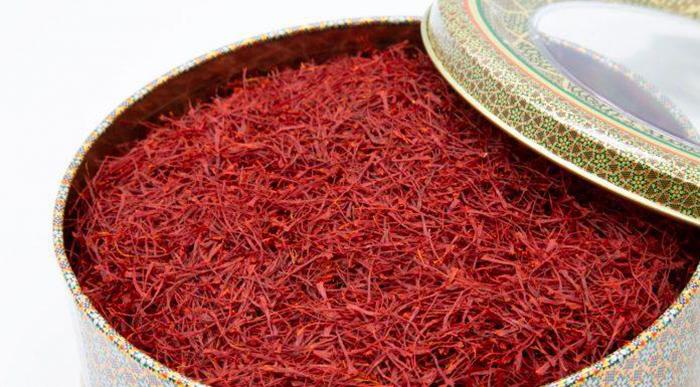
Manufacturers may use substandard colorants and preservatives when producing artificial saffron. Although some products have saffron in them, it is in extremely meager amounts.
The problem is that the artificial saffron's texture and color are so similar that it is difficult to identify. Therefore, be careful when buying saffron to avoid buying saffron-colored by turmeric or paprika instead of the original color.
It would help if you stored saffron in a glass bottle and put it in a cabinet, preferably a wooden cabinet, because the metal can melt in the summer. Saffron should be stored in a cool, dark place, away from direct sunlight.
Saffron pistil should not be stored in the refrigerator as saffron tends to absorb moisture easily once exposed to room temperature.
If you have to store it in the refrigerator, you need to quickly take out the required amount each time and immediately put the box or bottle back in the refrigerator. Saffron is best not to be held for more than 2 years.
8. Side effects to note when using saffron Iran
Using saffron for too long
When you consume any saffron supplement for weight loss, you should always be careful about timing. The usage period never lasts more than six weeks.
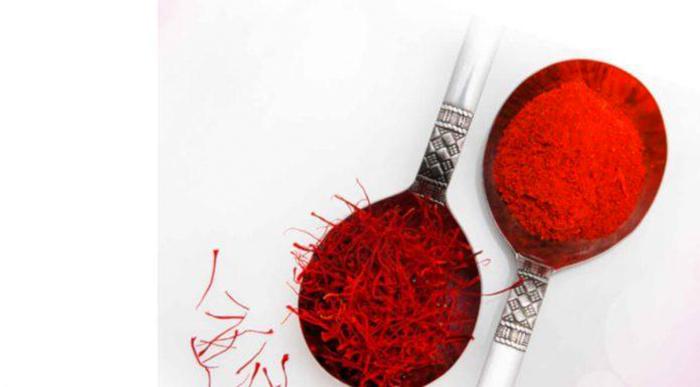
You should follow your professional's instructions on taking saffron, avoiding a sudden decrease or increase in your saffron consumption.
Overuse of saffron
Sometimes consuming too much saffron can be dangerous. If the amount of saffron pistil you use is between 10 mg and 20 mg, you should highly consult your doctor.
To avoid side effects, ideally, take no more than 5 mg per day. Doses consumed more than saffron can be fatal to the user.
Some of the common side effects of saffron overdose include jaundice, yellow eyes, diarrhea, food poisoning, mucosal jaundice, nosebleeds, numbness of the eyelids and lips.
For pregnant and lactating women
Consuming saffron can be risky for pregnant women. Using too much saffron can cause uterine contractions and lead to miscarriage.
Nursing mothers should avoid the same thing, as artificial colorants can enter the baby's body through breast milk. This is a hazardous side effect of saffron.
Some common side effects

The side effects of saffron often vary depending on the quality of the product. Sometimes, saffron allergy leads to a chain of side effects. Some of the widespread side effects of saffron pistil are the appearance of symptoms:
- Headache
- Concerned
- Dizziness
- Skin allergies
- Dry mouth
- Anorexia
- An upset stomach
- Nausea
- Weight loss
9. Benefits of Saffron To Improve Your Health
10. Where to buy saffron?
Saffron Iran is a very special saffron pistil, considered an “elixir” for the body. Hopefully, through this article, you have an overview of Iran saffron and consider using saffron to enhance your health.
Please follow BellyFatZone regularly for more useful information.
View more:
- Meal Plan For A Sedentary Office Worker Does Not Gain Weight And Keeps You Energized
- What Fruits For Weight Loss Quickly?
- Is Soy Milk Good for Bodybuilding?
Hopefully, the information above has helped you gain some more knowledge about “saffron benefits” and bring some small value. Please share this article if you feel it is useful. Thanks!






